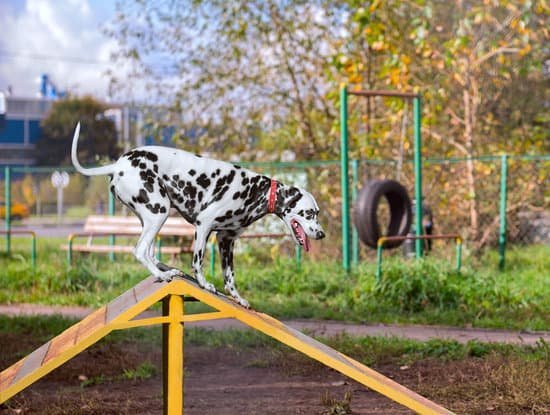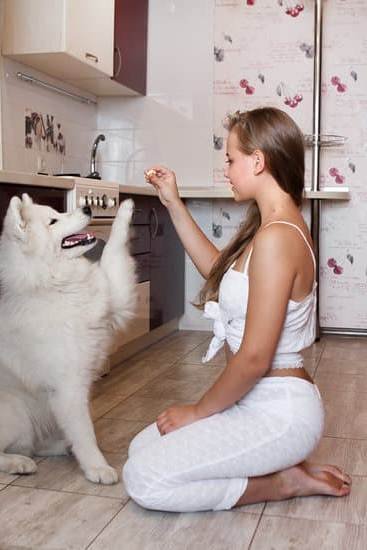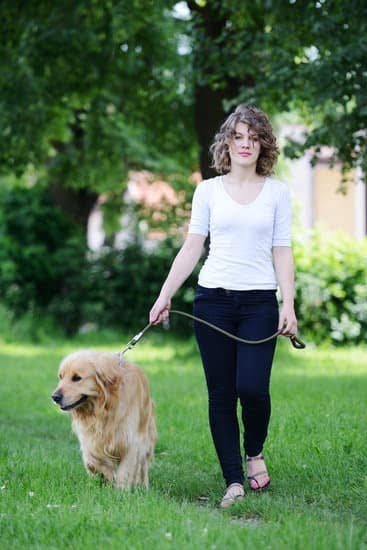Dogs are beloved companions and valued members of our families, but even the most well-behaved pooch can have accidents indoors. This is where potty training comes in, an essential skill for any dog owner. One innovative tool that can greatly aid in the potty training process is the potty bell.
The potty bell serves as a communication device between you and your dog, allowing them to alert you when they need to go outside to relieve themselves. Teaching your dog to use a potty bell not only provides them with an effective means of communication, but also helps prevent accidents inside the house and strengthens the bond between you and your furry friend.
In this comprehensive guide, we will explore everything you need to know about potty training dogs using a potty bell. From understanding the concept of potty bells to choosing the right one for your pup, step-by-step training techniques, troubleshooting common challenges, establishing consistency, transitioning from a potty bell to independent bathroom signals, and advanced tips and strategies – we’ve got you covered.
Make sure to stay tuned for our concluding section where we celebrate success and discuss the numerous benefits of having a potty-trained dog who effectively uses their trusty potty bell. Let’s get started on this exciting journey towards effective communication and stress-free potty training for both you and your four-legged friend.
Understanding the Concept of Potty Bells
Potty bells are a valuable tool for dog owners looking to effectively communicate with their pets during the potty training process. This section will provide a comprehensive guide on understanding the concept of potty bells and how they can be beneficial for both dogs and their owners.
What are Potty Bells?
Potty bells are essentially a set of jingle bells or doorbells that are hung from a doorknob or placed near an exit. These bells serve as a communication device, allowing your dog to signal when they need to go outside to relieve themselves. By teaching your dog to interact with the potty bell, you can avoid accidents in the house and establish a clear means of communication.
Benefits of Using Potty Bells
Using potty bells during the training process comes with several advantages. First and foremost, it provides your dog with a way to express their needs, reducing frustration and confusion for both of you.
It also helps prevent accidents by giving your dog an alternative method of signaling that they need to go outside, rather than scratching at doors or barking excessively. Additionally, using potty bells can strengthen the bond between you and your furry friend as you work together towards successful training.
Getting Your Dog Familiar with the Potty Bell
Introducing your dog to the concept of potty bell begins by making them familiar with its presence and sound. Hang or place the potty bell near their usual exit point or where they spend most of their time indoors. Encourage curiosity by letting them investigate the bell, rewarding any interaction with treats or praise. Eventually, your dog will associate the sound of the bell with going outside to use the bathroom.
Understanding these fundamentals will set you on the right path towards successfully incorporating potty bells into your training routine. In the next section, we’ll explore the factors to consider when choosing the right potty bell for your dog.
Choosing the Right Potty Bell
Materials and Design
When choosing a potty bell for your dog, it is important to consider the materials and design of the bell. The bell should be made of a durable material that can withstand your dog’s paws or nose hitting it repeatedly. Avoid bells that are too delicate or easily breakable, as they may not last long with regular use.
Additionally, pay attention to the size of the bell. It should be large enough for your dog to hit easily, but not so big that it becomes cumbersome for them to use. Consider the weight of the bell as well – you want it to be lightweight enough for your dog to ring without too much effort.
Sound
The sound of the potty bell is another important factor to consider. Look for bells that produce a clear and distinct sound that is easily noticeable by both you and your dog. Avoid bells that are too loud or shrill, as this may startle or scare your dog. Similarly, bells that produce a muted or muffled sound may not grab your attention when you’re in another room.
Some potty bells also come with adjustable volume settings, allowing you to choose a sound level that suits your needs and preferences. This can be particularly useful if you have neighbors nearby who may not appreciate constant ringing from a loud bell.
Placement Options
Consider where you plan to place the potty bell in your home when choosing one. Some potty bells are designed to hang on doorknobs, while others can be mounted on walls or placed on the ground using a stand. Think about which option would work best for your living situation and set-up.
If you live in an apartment or have limited space, a wall-mounted option might be more suitable, as it frees up floor space and reduces tripping hazards. On the other hand, if you have multiple doors that lead outside, a potty bell that hangs on a doorknob may be more practical.
Remember to consider your dog’s height and size when deciding on the placement of the potty bell. You want it to be easily accessible for them without having to strain or jump up too much.
By carefully considering these factors, you can choose a potty bell that meets your needs and preferences while ensuring success in potty training your dog.
Step-by-Step Guide
Introducing your dog to the potty bell is an important first step in potty bell training. This process helps your dog understand the purpose of the bell and how to use it effectively. Here is a step-by-step guide to help you introduce your dog to the potty bell:
- Choose the right location: Find a suitable spot for hanging the potty bell near your dog’s usual bathroom area. It should be at a height that allows your dog to easily reach and touch the bell with their nose or paw.
- Familiarize your dog with the bell: Allow your dog to investigate and sniff the potty bell without any pressure or expectations at first. Let them get comfortable with its presence in their environment.
- Set up a cue: Before introducing the potty bell, establish a verbal cue such as “touch” or “bell” that you will use consistently throughout the training process. Associate this cue with positive reinforcement, such as treats or praise.
- Introduce hand targeting: Teach your dog how to target their nose or paw to your hand by offering it in a closed fist position. When they touch or nudge your hand, provide praise and reward them with treats.
- Transfer targeting behavior to the potty bell: Once your dog is comfortable targeting your hand consistently, associate this behavior with the potty bell by placing it in front of them while offering your closed fist as a target. Encourage them to touch the bell instead of your hand.
- Reinforce desired behavior: Whenever your dog shows interest in or interacts with the potty bell, immediately reward and reinforce their behavior with treats and praise. This positive reinforcement will help them understand that touching the bell is desirable.
- Practice regularly: Repeat these steps daily until your dog consistently targets and touches the potty bell with their nose or paw when prompted by the verbal cue. Gradually increase distance between yourself and the bell to encourage independent behavior.
Remember, consistency and patience are key during this training process. Ensure that each training session is short and positive to keep your dog engaged and motivated. With time and practice, your furry friend will become proficient in using the potty bell, making potty training a breeze for both of you.
Training Techniques
Teaching your dog to ring the potty bell on command is an essential part of potty bell training. This section will guide you through the step-by-step process of teaching your dog this important skill.
- Start by Hang the Bell: Begin by hanging the potty bell near the door that leads to your dog’s designated bathroom area. Make sure it is within reach for your dog. You can use a hook or string to hang it at a height that allows your dog to easily touch it with their nose or paw. Ensure that the bell makes a clear sound when it is rung.
- Introduce the Bell: Once you have hung the bell, introduce it to your dog. Encourage them to investigate and sniff the bell by using treats or their favorite toy as a reward. Allow them to get familiar with it without putting any pressure on them to ring it yet.
- Associate the Bell with Going Outside: The next step is to associate ringing the potty bell with going outside for bathroom breaks. Every time you take your dog out, say a specific command such as “Go outside,” and then lead them to ring the bell before opening the door. This will help them understand that they need to ring the bell if they want to go outside for bathroom purposes.
- Reinforce Bell Ringing Behavior: When your dog shows interest in or touches the bell with their nose or paw, immediately praise and reward them with treats and verbal praise. You can also use a clicker if you have previously trained your dog using this method.
- Add a Command Cue: As your dog becomes more comfortable with touching the bell, start adding a verbal cue such as “Ring” or “Bell.” Say this cue each time they touch or interact with the potty bell, reinforcing their understanding that ringing it will lead to going outside.
- Repeat and Practice: Consistency is key in teaching your dog to ring the potty bell on command. Repeat this training process several times throughout the day, especially during your dog’s usual bathroom times. Practice until your dog confidently rings the bell on command without needing any physical guidance or rewards.
By following these training techniques, you can successfully teach your dog to ring the potty bell on command, making it easier for them to communicate their need to go outside. Remember to be patient and consistent throughout the training process, and soon enough, your dog will understand how to use the potty bell effectively.
Troubleshooting Common Challenges
Training a dog to use a potty bell may not always be a smooth process. There can be various challenges and obstacles that you may encounter along the way. However, with patience, consistency, and the right techniques, you can overcome these challenges and successfully train your dog to use a potty bell.
One common challenge in potty bell training is that some dogs may ignore or show no interest in the bell. If this happens, it is important not to get discouraged. Instead, try to make the bell more enticing for your dog.
You can do this by using treats or toys as rewards when they ring the bell correctly. Additionally, you can try moving the bell to a different location or changing its appearance to make it more appealing to your dog.
Another challenge that dog owners may face is their pets ringing the bell excessively or at inappropriate times. To address this issue, it is crucial to reinforce specific cues or commands associated with ringing the bell.
For example, teach your dog a command such as “Go potty” or “Ring the bell” before allowing them access to go outside. By doing this consistently, your dog will learn that ringing the bell should only be done when they actually need to go outside.
Furthermore, some dogs may struggle with understanding the connection between ringing the potty bell and going outside to eliminate waste. In these cases, it can be helpful to accompany your dog outside every time they ring the bell and give them ample opportunity to perform their bathroom duties. Rewarding them immediately after they have gone potty will reinforce the association between ringing the bell and going outside for elimination.
By being aware of these common challenges and applying appropriate techniques to overcome them, you can ensure successful potty bell training for your furry friend.
| Common Challenge | Solution |
|---|---|
| Dog ignores or shows no interest in the bell | Make the bell more enticing by using treats or toys as rewards when they ring the bell correctly. Try moving the bell to a different location or changing its appearance. |
| Dog rings the bell excessively or at inappropriate times | Reinforce specific cues or commands associated with ringing the bell, such as teaching your dog a command like “Go potty” or “Ring the bell” before allowing them access outside. |
| Dog struggles to understand connection between ringing the bell and going outside for elimination | Accompany your dog outside every time they ring the bell and give them ample opportunity to perform their bathroom duties. Reward them immediately after they have gone potty. |
Consistency is Key
Establishing a routine is crucial when it comes to potty bell training for dogs. Consistency allows your furry friend to understand and learn the desired behavior more effectively. Here are some key steps and tips to help you establish a routine for successful potty bell training:
- Set a Regular Schedule: Dogs thrive on a consistent schedule, so it’s important to establish regular times for bathroom breaks. Take your dog outside at similar times every day, such as after meals, playtime, and waking up in the morning. This will help your dog associate certain times with going outside to potty.
- Use Positive Reinforcement: When your dog rings the potty bell or successfully goes outside to do their business, reward them with praise and treats. Positive reinforcement will reinforce the behavior and encourage them to repeat it in the future.
- Be Patient and Consistent: Your dog may not catch on immediately, but consistency is key. Keep following the same routine every day and be patient with their progress. Eventually, they will understand that ringing the bell leads to going outside and will start doing it consistently.
| Breed/Size of Dog | Average Timeframe for Consistency |
|---|---|
| Small breeds (e.g., Chihuahua, Yorkshire Terrier) | 1-3 weeks |
| Medium breeds (e.g., Cocker Spaniel, Beagle) | 2-4 weeks |
| Large breeds (e.g., Labrador Retriever, Boxer) | 3-6 weeks |
Remember, every dog is different, and the time it takes for them to become consistently reliable with using the potty bell may vary. Stay consistent, patient, and positive throughout the training process, and you’ll soon have a well-trained dog who knows exactly when they need to go outside to do their business.
Gradual Transition
Once your dog has mastered the concept of using the potty bell consistently, it may be time to start thinking about transitioning them to independent bathroom signals. This transition is an important step in your dog’s potty training journey, as it allows them to communicate their needs without relying solely on the potty bell. Here are some tips and strategies for making this gradual transition.
Firstly, it’s crucial to continue using the potty bell during this transition period. Rather than completely eliminating the potty bell altogether, you can gradually reduce its use over time. Start by introducing a verbal cue or a specific action that your dog can associate with going outside to use the bathroom. For example, you can say “outside” or clap your hands before opening the door.
Next, whenever you notice your dog exhibiting signs that they need to go outside, give them a command or signal associated with going potty. This could be pointing towards the door or saying a specific word such as “bathroom.” Be consistent with this signal so that your dog understands what you expect from them.
As your dog becomes more accustomed to responding to these verbal cues or actions, you can begin phasing out the potty bell altogether. Gradually increase the number of times you rely on the verbal cue instead of using the potty bell. Over time, your dog will connect the new bathroom signal with their need to go outside and will respond accordingly.
It is important to remember that this transition may take some time for your dog to fully grasp. Be patient and consistent throughout the process, reinforcing positive behavior with rewards and praise. If accidents occur during this stage, avoid scolding or punishing your dog as this can hamper their progress and create negative associations with bathroom signals.
By gradually transitioning from using a potty bell to independent bathroom signals, you are empowering your dog to communicate their needs without relying on a physical object. This not only reinforces their potty training but also gives them a sense of confidence and independence. With dedication and consistency, your dog will soon be able to let you know when it’s time for them to go outside, making your life as a pet owner much easier.
Advanced Tips and Strategies
Once your dog has mastered the basics of potty bell training, you may be ready to take their training to the next level. Here are some advanced tips and strategies that can help you further refine your dog’s potty bell skills.
- Increase Distance and Duration: Once your dog is consistently using the potty bell to signal their need to go outside, you can start increasing the distance between them and the bell. Start by moving a few feet away from the bell when they ring it, gradually increasing the distance over time.
Additionally, you can also increase the duration between when your dog rings the bell and when they are let outside. This helps reinforce the connection between ringing the bell and going outside to eliminate. - Add Verbal Cues: Introducing verbal cues can enhance your dog’s ability to communicate their needs even more effectively. When your dog rings the potty bell, pair it with a specific command such as “outside” or “bathroom.” Repeat this command each time they ring the bell before taking them outside. With consistent practice, your dog will learn to associate these verbal cues with going outside for bathroom breaks.
- Differentiate Between Bathroom Breaks and Playtime: Dogs are smart creatures, and they quickly learn patterns of behavior. To avoid confusion, teach your dog different signals for bathroom breaks versus playtime or outdoor exploration.
For example, if your dog rings the potty bell but does not eliminate after being let outside, calmly lead them back inside without engaging in play or other activities. This teaches them that ringing the bell specifically means it’s time for a bathroom break. - Maintain Consistency in Reinforcement: As you advance in potty bell training, it’s important to remain consistent in reinforcing desired behaviors. Continue rewarding your dog with praise, treats, or a walk every time they successfully use the potty bell to alert you. Additionally, it’s essential to stay vigilant and respond promptly to your dog’s signals. Consistency will help solidify their understanding of the potty bell concept and reinforce good habits.
Remember that every dog is unique, and training progress can vary. Patience, consistency, and positive reinforcement are key when implementing advanced tips and strategies in potty bell training. With time and practice, your dog will become even more skilled at communicating their need to go outside using the potty bell. Stay committed to the training process, and soon you’ll enjoy the benefits of having a well-trained dog who can effectively communicate their potty needs.
Conclusion
In conclusion, training your dog to use a potty bell can bring about numerous benefits for both you and your furry friend. By following the step-by-step guide and implementing the training techniques outlined in this article, you can successfully teach your dog to ring the potty bell on command. With consistency and patience, you will be able to establish a routine that is essential for successful potty bell training.
Once your dog has mastered the art of using the potty bell, you will begin to see the many advantages that come with this training method. Firstly, it provides a clear communication channel between you and your dog, eliminating any confusion or guessing games when it comes to bathroom breaks. This not only saves time and frustration but also strengthens the bond between you and your pet.
Another benefit of potty bell training is that it gives your dog a level of independence when it comes to signaling their bathroom needs. While they may initially rely on the potty bell as a cue, over time they will develop their own ways of communicating when they need to go out. This gradual transition promotes confidence in your dog and empowers them to take responsibility for their own hygiene needs.
Frequently Asked Questions
How do you train a dog to use a bell potty?
Training a dog to use a bell potty involves several steps that require consistency and positive reinforcement. First, choose a specific bell or set of bells to hang near the door leading outside. Then, introduce your dog to the bell by associating it with going outside to potty. Encourage your dog to touch or interact with the bells using treats or verbal cues like “touch” or “ring.”
Once your dog has made this connection, start practicing by prompting them to touch the bells before going out for bathroom breaks. Reinforce this behavior with praise and rewards every time they ring the bell successfully. Eventually, your dog will learn that ringing the bell leads to outdoor access when they need to go.
Do potty bells work for dogs?
Potty bells can be an effective tool for dogs when it comes to signaling their need to go outside and reducing accidents in the house. However, their success relies on proper training and consistency from the owner. Some dogs quickly learn to associate ringing the bells with going out to eliminate, while others may take more time or require additional reinforcement methods.
It’s important for owners to commit to consistent training and providing positive rewards each time the dog rings the bell correctly. This reinforces the desired behavior and helps establish a clear communication between the dog and its owner when it needs to relieve itself.
What is the hardest dog to potty train?
The hardest dog breeds to potty train can vary depending on individual temperament, intelligence, and previous training experiences. Generally speaking, smaller toy breeds such as Chihuahuas, Bichon Frises, or Dachshunds are often considered more challenging due to their independent nature and potential difficulties with bladder control.
Additionally, some terrier breeds like Jack Russell Terriers or Bull Terriers can also present challenges as they tend to have strong-willed personalities that may require extra patience during house training endeavors. However, it is crucial not to generalize as every dog is unique in its own way, and successful potty training can be achieved with any breed or mixed-breed dog given the right training techniques and consistency.

Welcome to the blog! I am a professional dog trainer and have been working with dogs for many years. In this blog, I will be discussing various topics related to dog training, including tips, tricks, and advice. I hope you find this information helpful and informative. Thanks for reading!





